One of the best early-ripening and unpretentious varieties is the Lyubasha f1 tomato: yield and characteristics
A review of the new hybrid tomato Lyubasha will introduce the characteristics and description of the variety, reveal the secrets of productivity, and provide photos and reviews for illustrative examples. Opinions about the variety of those who planted indicate a high fruiting rate, ease of care, resistance to disease and excellent taste of the fruit. Despite its short existence in the tomato world, the variety has endeared itself to many vegetable growers, for whom Lyubasha is a welcome guest in the garden.
Description of the variety
Tomato Lyubasha f1 was bred by breeders of the Partner company in 2016. Included in the State Register in 2017. Recommended for cultivation in all regions of the country in protected and unprotected soil.
Bush determinant, height 1 m, compact. Leaves are medium in number, small, bright green. The inflorescences are simple. The first inflorescence is formed above the 5-6th leaf. The brush sets up to 8 fruits.
Ultra-early ripening hybrid: 65-75 days pass from the moment of germination to full ripening.
The productivity is high, up to 5 kg of vegetables are harvested from one bush, provided that 4-6 bushes are planted per 1 square meter. m.
Resistant to major diseases of the nightshade family.
Despite their short stature and compactness, the plants require staking and pinching.
The fruits are round in shape, slightly flattened. The color is bright red. Not prone to cracking in either cold or rainy weather. There are 3–4 seed chambers, not many seeds. The peel is dense. Weight 120-150 g.
Universal in use: suitable for fresh consumption, for whole-fruit canning, for the production of tomato products: juices, pastes, ketchups, lecho. Good in pickles and marinades. They do not lose their delicious taste when dried.
Ripe vegetables can be stored for a long time and can withstand long-term transportation.
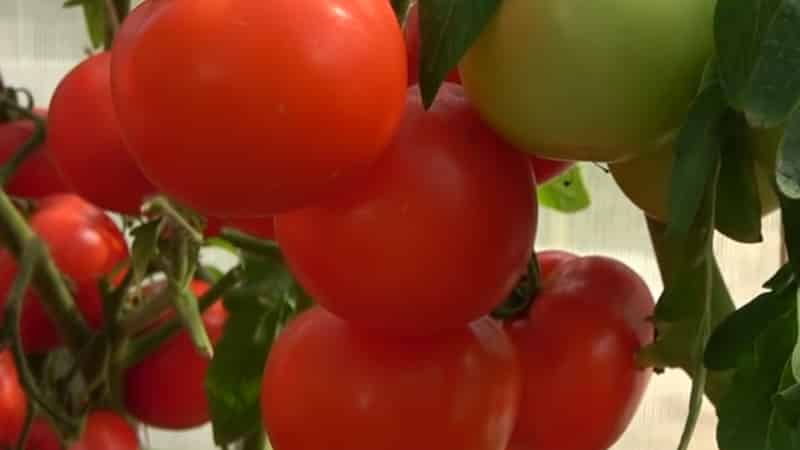
How to grow seedlings
Sowing of seeds occurs 55-60 days before planting seedlings in the ground. The soil mixture is prepared from garden soil, mixing it with peat and compost. If possible add ash.
Reference! If garden soil contains clay, it must be mixed with washed river sand or sawdust. This technique will make the soil loose, which will facilitate better penetration of air into the soil.
The prepared soil is disinfected with a solution potassium permanganate. Then the seed is disinfected. To do this, the grains are placed in a weak solution of manganese or in a solution of Fitosporin for 20 minutes.
You can plant in a common wooden box or in individual peat pots and plastic cups. The main thing is to make drainage holes in the planting container to prevent stagnation of water.
Important! To improve germination, the seeds are placed in a growth stimulator for 5 hours.
Seeds are sown in slightly moistened soil with a distance of 2-3 cm between them. The seeded containers are covered with film or glass and left in a room where the air temperature is at least 23 degrees.
The first shoots can be seen on days 4-7. When sprouts appear, you must immediately move the containers to the light. Otherwise, the bushes will stretch and weaken.
The soil is kept moist by watering it only with settled and warm water.
The optimal daylight hours for seedlings are at least 12 hours a day.If there is not enough daylight, artificial lighting lamps are used as additional lighting.
At the stage of seedling growth, the hybrid does not need feeding.
When 3 true leaves appear, pick them. During picking, the seedlings are planted in looser boxes, with a distance of 20 cm between the sprouts, or in a separate container.
The first two weeks after emergence, they are subjected to hardening, which consists of maintaining a lower temperature than usual. During the day the temperature drops to 16 degrees, and at night to 13.
2 weeks before planting in the ground, the seedlings are taken out into the open air on sunny days for rapid adaptation to street conditions.
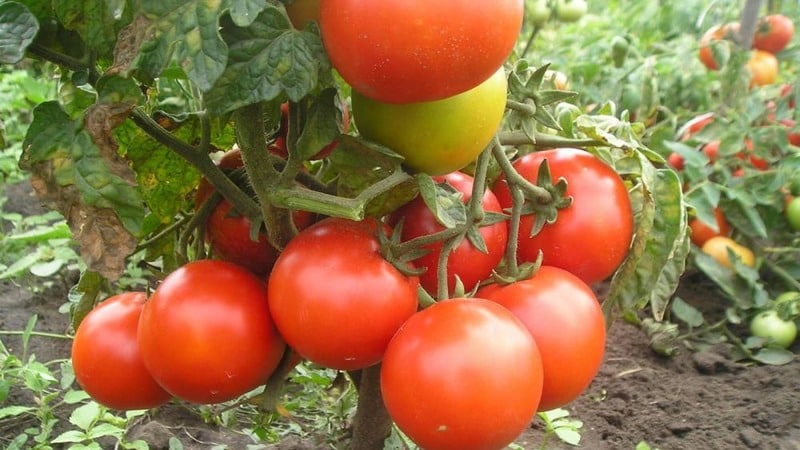
How to grow tomatoes
After 55-60 days, the seedlings are ready for transplanting. At this time, the bushes already reach 25 cm in height, they have a strong stem, 8-9 leaves and the first flower cluster begins to form.
On the eve of planting, the soil is watered abundantly, and compost and ash are placed in each hole. Fresh manure should never be used as fertilizer when planting.
For tomato beds, choose a sunny, unshaded place where light reaches throughout the day.
For 1 sq. m, 4-5 seedlings are planted. The distance between plants is 35-40 cm.
A few days later, as the sprouts strengthen, the first watering is carried out with warm, settled water at the root. Water once a week on hot days – 2 times a week. Each bush uses 4-5 liters of water. The plant responds well to drip watering. You can also pour water into pre-prepared containers located in the root zone, from where the water will gradually penetrate to the roots of the plant. A regular plastic bottle without a bottom is suitable for this.
After watering, the soil is loosened, hilled up and weeds are removed. Loosening promotes the formation of additional roots. Mulching beds keep them moist longer and prevent weed growth. Watering is stopped 2.5 weeks before harvesting vegetables.
The first feeding is carried out on the 10th day after planting. Fermented grass is used as fertilizer in a ratio of 1:10. When the ovaries appear, phosphorus-potassium fertilizers are added. Fertilizing is carried out after watering, every 2 weeks.
Culture requires mandatory stepsoning. Bushes are formed into 2 or 3 stems. When growing in 2 trunks, leave the stepson under the first flower cluster. When growing in 3 trunks, 2 stepsons are left: under the first flower cluster and above it. But experienced gardeners advise growing bushes with 4 stems; according to their estimates, this technique promotes maximum fruiting.
Reference! A larger number of stepchildren are left in the southern regions.
As it grows, the bush requires staking, despite the strong stems. For gartering, use wooden stakes, rigid trellises or twine. If the plant is not tied up, the fruit clusters will break under their own weight.
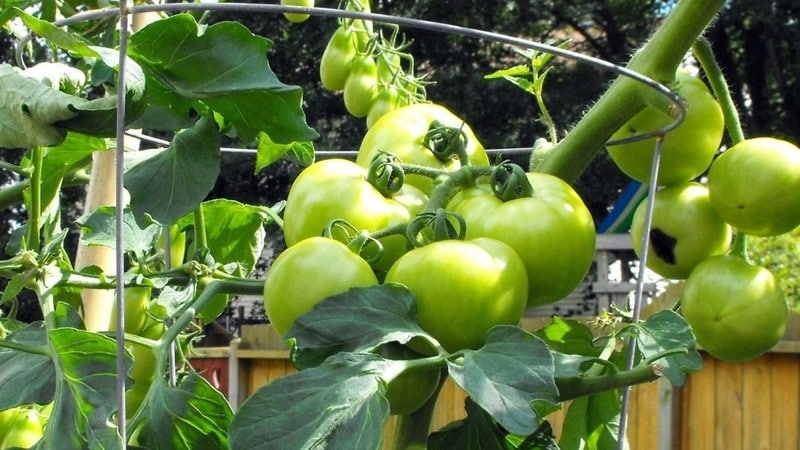
Diseases and pests
Lyubasha f1 tomatoes are characterized by increased resistance to diseases, such as blossom end rot, tobacco mosaic, and late blight. In addition, early ripening periods allow the crop to not linger in the beds for a long time, which protects it from prolonged attacks by pests.
Compliance with the rules of crop rotation and agricultural technology strengthens the plant’s immunity. And if you add preventive measures to all the rules of care, then your tomato crops will stand up well even against hordes of pests.
Ground pests: slugs, Colorado potato beetles, ticks are afraid of wormwood infusions, garlic And hot pepper, which scare them away with their smell. Regular inspection also reliably protects the bushes from their appearance.
Deep digging of the soil before planting contributes to the destruction peststhat disrupt the root system. These include beetles, wireworms, and mole crickets. Treating the soil with lime or dolomite flour also prevents their appearance.
To prevent fungal and bacterial diseases, biological preparations “Alirin” or “Gamair” are well suited.
The nuances of growing in open ground and in a greenhouse
The culture is equally well adapted to open ground and to greenhouse. But in a protected ground productivity is higher.
Growing in a greenhouse leads to waterlogging, which is manifested by a surge in fungal diseases. To avoid this, ventilate the greenhouse regularly. But remember that tomatoes do not like drafts.
Outdoors, for tomato beds, choose a sunny place, open, but protected from strong winds. A slight breeze will prevent fungal spores from settling. In open ground, the greatest likelihood of attacks by insect pests remains, with the exception of spider mites, which prefer greenhouse conditions. Therefore, if the variety is planted outside, the main preventive measures are to protect the beds from insects.
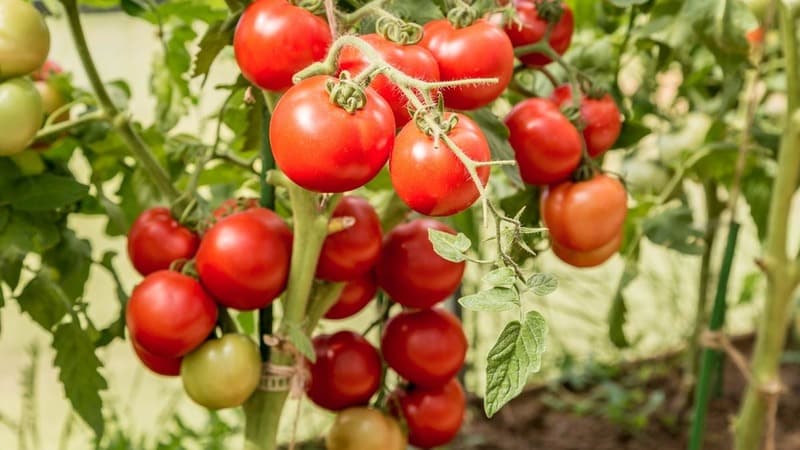
Harvesting and application
Vegetable harvesting begins in the last ten days of June - early July. Ripening occurs in clusters, the vegetables ripen at the same time, which greatly simplifies their collection. You can cut off entire branches with fruits.
Ripe vegetables are used fresh, in pickles, in marinadesin preparing various dishes. Due to their small size, they are well suited for canning whole fruits.
Indispensable in vegetable dishes such as stews and purees. They complement first courses well: borscht, soups. Ideal for baking with meat products and other vegetables. They are also suitable for preparing tomato products: they produce delicious juice, excellent adjika and lecho. They act as the basis for a variety of sauces. Ripe tomatoes can even be dried, thanks to their dense pulp.
This variety is intended for long-term storage without loss of taste and appearance. Transfers transportation over long distances, which makes it possible to transport ripe vegetables to other regions for sale.
Advantages and disadvantages
Any hybrid is obtained by crossing two carefully selected varieties in order to preserve their best qualities in the future generation. Therefore, speaking about a hybrid, we can note many positive properties:
- ultra-early ripening;
- possibility of breeding in any region;
- high resistance to diseases;
- simple agricultural technology;
- high productivity;
- fruit ripening at the same time;
- excellent taste;
- versatility in application;
- possibility of whole-fruit canning;
- long-term storage;
- long transportations.
The main drawback of all hybrids is the inability to independently select seeds for the next planting. Seed material will have to be purchased in specialized stores. The remaining shortcomings of culture are insignificant; they can be called conditional:
- required garter;
- stepsoning required.
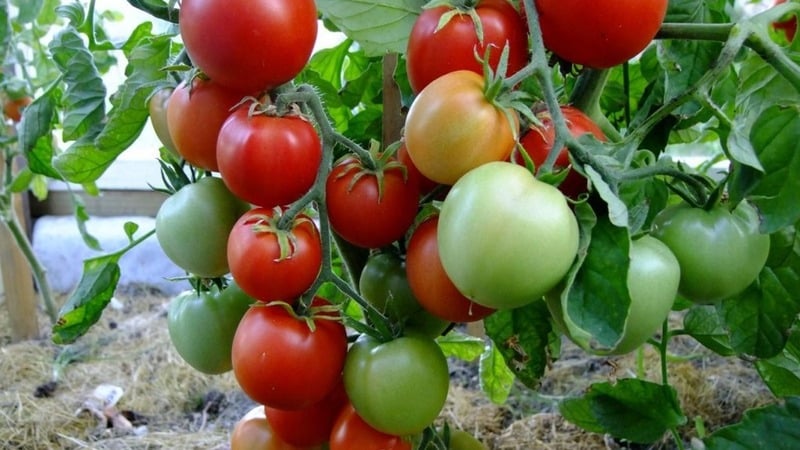
Farmer reviews
Despite its short lifespan, the variety has managed to attract the attention of many vegetable growers.The new hybrid meets all the basic requirements and is quite capable of competing with crops that have proven themselves in the tomato world.
It is quite possible that in the near future the variety will begin to be widely used on an industrial scale, deriving decent profits from it. But for now, experiments with the young hybrid are taking place in summer cottages.
Let's get acquainted with the opinions of gardeners:
Tatyana, Orel: “The weather this year was not tomato-like at all, cold and rainy. Many varieties were destroyed by late blight, but the hybrid survived. The vegetables turned out delicious, and now I’ll be stocking up all winter. It’s very good that I planted this variety, otherwise I would have been left without tomatoes.”
Elena, Kursk: “A completely normal variety. I didn’t prune and didn’t water often. But there were tomatoes. The taste is quite satisfactory, typical for tomatoes, with sourness. The skin is dense, perfect for blanks. It’s a pity that you can’t prepare the seeds yourself. Will have to buy again. Thank God the price is affordable.”
Dinara, Krasnoyarsk: “The variety sprouted with difficulty, the bushes are modest, with 2-3 fruiting clusters. But we survived our cold summer. There were few vegetables. I don’t even know if I’ll plant it next year.”
Conclusion
The Lyubasha f1 tomato species has proven itself to be high-yielding, easy to care for, disease-resistant and well adapted to open ground and greenhouse conditions. But unpretentiousness in care does not mean a complete lack of attention to the plant.
Like any other crop, the variety needs timely feeding and watering. And if you follow the rules of crop rotation, Lyubasha will respond with a variety of delicious tomatoes that will decorate your tables both in summer and winter. The name of the variety reflects its very essence. I just want to say: it’s fun and inexpensive.